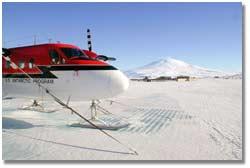14 September, 2003
Possible Medical Airlift
The rumor mill is flying here at McMurdo, and I do not want to add to
it so I am trying to be careful here with my remarks. The NSF has
put out an official bulletin and you can search for that on Google
for the hard facts.
A person is sick at the South Pole station and there is talk about a
medical airlift to bring this person to a facility that can care for
him. Everyone is wondering when it will happen, but the thought is
that it will be in just a few days when weather allows for it. A
final decision from NSF has not been made. Having a plane come here
at this time of year is well out of the routine. And having a plane
go to the South Pole at this time of year is a very rare occurrence.
It is very cold at the South Pole, at least minus 50F, and it is
located nearly 10,000 feet high on Earth's ice cap. The weather is
changing rapidly with Spring approaching and this causes high winds.
Currently the forecast this week looks good for the weather at the
South Pole as it appears to be warming considerably and there may be
a sun break on Wednesday. A small plane can make it there but it is
considered a very dangerous flight. NSF would only launch such a
mission if a person's life depended on it.
All personnel going to Antarctica complete a comprehensive medical
check before coming here. I had a complete physical and dental
check; some people even get their wisdom teeth pulled before coming
here. However, unforeseen complications will arise. Our station has
a small medical facility with a qualified doctor at all times.
People who will spend the entire winter here must also go through
psychological testing. You should not think of everyone here as
super athletes, we are just like everyone else, overweight,
underweight, and some people here even smoke (yuck).
Here at McMurdo, preparations have begun. The old runway, Pegasus,
which I flew in on at Winfly, had been abandoned as they prepared the
new ice runway. The idea was that they did not want to ruin Pegasus
when the weather warms, so they allowed it to be covered in snow. If
a C41 does have to make a landing here it will need to use Pegasus
because the ice runway is not ready yet. That means crews have to
get the old runway functional. Personnel have to be shifted, the
fire crew has to prepare, and all things must be in place as the C41
will not stay but a few hours or it would risk being stuck here.
If it does occur then a twin otter aircraft would fly from Chile to
Rothera, the British station, and then to the pole. It could either
return that way or come back to McMurdo where it would meet a C41 or
similar military transport.
All of this comes at incredible expense and human effort. Whether to
unduly risk people's lives in a rescue is a difficult decision for
the National Science Foundation to make, and it is testimony to the
remoteness of this continent and the importance of our science
mission here. We all wish the best for the people involved.

A view of a Twin Otter craft that might be used for the airlift. (from NSF files)
Contact the TEA in the field at
.
If you cannot connect through your browser, copy the
TEA's e-mail address in the "To:" line of
your favorite e-mail package.
|
